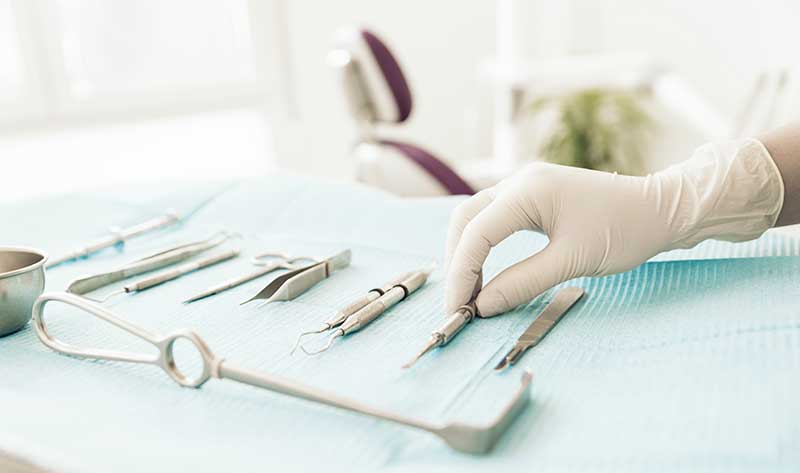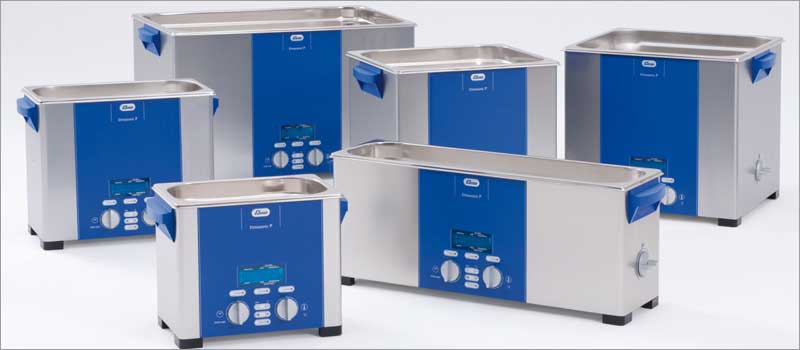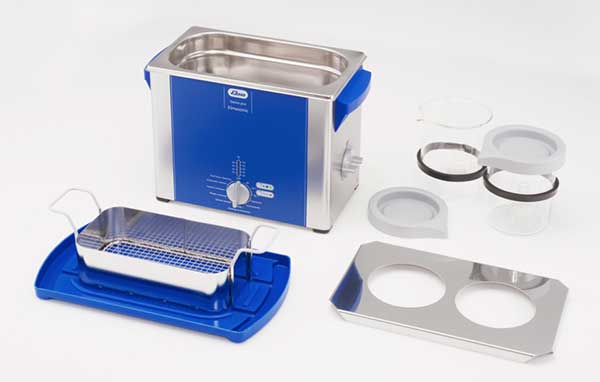
Ultrasonic Cleaner for Dental Instruments
Using an ultrasonic cleaner for dental instruments is a recommend practice cited by professional organizations including the American Dental Association, the Food and Drug Administration and the CDC’s Summary of Infection Prevention Practices in Dental Settings to remove contaminants from reusable dental instruments.
Clinics employ ultrasonic cleaners for dental instruments before sterilization to avoid heat “baking on” blood, tissue and other organic residues that cause infection problems. Dental instrument ultrasonic cleaning systems are also ideal for cleaning molds, implant hybrid prosthesis, and removing plaster and cement from bridgework.
Why Clinics Need an Ultrasonic Cleaner for Dental Instruments
Ultrasonic energy creates billions of minute vacuum bubbles in an ultrasonic cleaning bath that implode with tremendous force when they contact dental instruments.
The process, called cavitation, reaches into tiny cracks and crevices, quickly and safely blasting loose and carrying away contaminants on dental instrument surfaces. Dental instrument ultrasonic cleaners are faster, safer and more efficient than mechanical washers or manually scrubbing sharp and pointed instruments.
Only after a thorough ultrasonic cleaning should dental instruments move to the second and third stage: disinfecting or sterilization then packaging. That is because residues interfere with microbial inactivation and can compromise subsequent processes, according to the CDC.
In summary, a dental instrument ultrasonic cleaner can be considered a “best practice” to remove these contaminants.
Operating Ultrasonic Dental Instrument Cleaners
Bench or table-top dental ultrasonic cleaners are available in several sizes. An example is the 1.5 gallon Elmasonic EP60H available from Tovatech. It can be used to clean instruments such as picks, drills, mold spoons; prostheses such as dentures and crowns, and to remove cement and plaster.
A 5-Step Procedure for Ultrasonic Cleaning Dental Instruments
- Until instruments are ready to be cleaned keep them immersed in either a germicidal or enzymatic presoak such as PreZyme. Do not let instruments dry out before ultrasonic cleaning.
- Use an ultrasonic cleaning solution formulated for cleaning dental instruments. A suggestion is UltraDose™ Germicidal, an EPA registered product that both cleans and disinfects in the ultrasonic dental cleaner bath. Diluted to 1 oz. per gallon of water it is an economical solution to cleaning reusable dental instruments.
- Objects to be cleaned are placed in a mesh tray or basket that is suspended by its handles into the ultrasonic cleaning solution so that the instruments are fully immersed*.
- Cleaning time (typically 7 to 10 minutes depending on the size of the load) and the temperature are set using the intuitive control panel and the unit turned on. Note that solution temperatures should be kept below 42°C (107⁰F). Otherwise particles could “bake” on the instruments and cannot be removed by sterilization.
- When the ultrasonic cleaning cycle is completed, rinse the instruments in water to remove solution residue and then move to the disinfecting or sterilizing steps to complete the process. As an interim step Barrier Milk can be used to lubricate hinges and prevent corrosion.
The ultrasonic dental cleaner solution should be changed at least once a day and the tank thoroughly cleaned and allowed to dry before being refilled with fresh solution.
Follow the Instructions provided by manufacturers of ultrasonic cleaning equipment and solutions. A side-mounted knob on the EP60H is turned to drain used cleaning solution via a valve on the back of the unit.
Selecting an Ultrasonic Dental Instrument Cleaner for Your Practice
Several points must be considered when you select your dental ultrasonic cleaner. Here we present a brief summary followed by other equipment options.
- Cleaning Tank Capacity
The internal dimensions of the tank are important, but more critical are the dimensions of the mesh basket that holds your instruments. Basket dimensions are slightly smaller than tank dimensions. Instruments must be completely immersed and should not be in contact with each other. - Ultrasonic Frequency
A frequency of 37 kHz or 37,000 cycles per second is ideal for most dental instrument cleaning requirements. Multi-frequency units are used for cleaning tasks such as difficult-to-remove contaminants (lower frequencies) or cleaning equipment with highly polished or complex surfaces (higher frequencies). - Sweep
Sweep provides a slight ± variation in ultrasonic frequency to promote more uniform distribution of cleaning energy. - Pulse
Pulse provides a 20% increase in power to remove difficult-to-remove contaminants. - Temperature Controls
As noted above a high solution temperature can cause contaminants to bake on surfaces. The process of ultrasonic cavitation heats the solution. Long cleaning cycles may call for a cooling coil to control solution temperature. In other cases the ability to heat a solution may be helpful for other cleaning tasks. - Timer
A timer lets you set cleaning cycle duration and attend to other matters.
Further useful functions
- A degas mode removes air from fresh cleaning solutions. Air inhibits ultrasonic cavitation.
- A lid helps mute the sound of cleaning action and reduces solution evaporation. Reversible lids serve as a drip tray when baskets are removed and contents inspected.
- Tank Drains are desirable on larger units when it’s time to replace cleaning solutions.
Other Dental Ultrasonic Cleaner Models
The Elmasonic EP60H mentioned above is one of a family available in 9 tank sizes from .25 to 7.5 gallons.
Here are some others:
The Elmasonic Select Series

Elmasonic Select offers 5 ultrasonic modes to optimize parts cleaning, sample preparation, and solvent degassing.
Key Features
- 5 Modes for thorough, rapid cleaning, mixing, degassing
- Timer 1 min to 6 hours; Heater to 80°C
- Stores up to 4 programs: time, temp, ultrasonic mode
- Extra-large digital display; signals when run is complete
- 11 tank sizes from 0.75 to 24 gal
The Elmasonic P Series
Offers total control over the ultrasonic process
- Six tank sizes from 0.75 gal to 7.5 gal
- Variable ultrasonic power
- 4 Modes for cleaning, mixing, degassing
- Dual frequency: 37 kHz and 80 kHz
- Timer and heater up to 80° C
The Ultimate Option – the Elmasonic Denta pro
This is a programmed ultrasonic cleaning unit to automatically manage common cleaning challenges in dental clinics thanks to its preset programs that guarantee a standardized cleaning process for each cleaning cycle.
With the Denta pro it is no longer necessary to manually set parameters such as cleaning time, temperature, Sweep and Degas. Simply select the required cleaning program and press the “Start“ key to initiate the cleaning task.
Cleaning options include
- dentures
- drills
- molds
- plaster removal
- cement removal
- and for enzymatic and acid cleaning
In Conclusion:
Dental offices and clinics that use ultrasonic cleaners for dental instruments should see increased productivity and cleaning effectiveness while reducing staff exposure to dangerous contaminants and risk of injury due to sharp edges.
Please contact our scientists for further details and for suggestions on ultrasonic systems best suited to clean your dental instruments.


